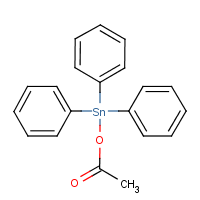Triphenyltin acetate
Agent Name
Triphenyltin acetate
Alternative Name
Fentin acetate
CAS Number
900-95-8
Formula
C20-H18-O2-Sn
Major Category
Metals

Synonyms
(Acetyloxy)triphenylstannane; Acetate de triphenyl-etain [French]; Acetato di stagno trifenile [Italian]; Acetatotriphenylstannane; Acetoxy-triphenyl-stannan [German]; Acetoxy-triphenylstannane; Acetoxytriphenyltin; Batasan; Brestan; Brestan 60; ENT 25208; Fenolovo acetate; Fentin acetaat [Dutch]; Fentin acetat [German]; Fentin acetate [BSI]; Fentin azetat [German]; Fentinacetat; Fentine acetate [French]; Fintin acetato [Italian]; GC 6936; HOE-2824; Liromatin; Lirostanol; OMS 1020; Phenostat A; Phentin acetate; Phentinoacetate; Stannane, (acetyloxy)triphenyl-; Stannane, acetoxytriphenyl-; Suzu; TPTA; Tin triphenyl acetate; Tin, acetoxytriphenyl-; Tinestan; Tinestan 60 WP; Tinestan WP 20; Tinestan WP 60; TPZA; Trifenil stagno acetato [Italian]; Trifenyl-tinacetaat [Dutch]; Triphenyl-zinnacetat [German]; Triphenylaceto stannane; Triphenylstannium acetate; Triphenyltin(IV) acetate; Tubotin; VP 19-40; [ChemIDplus] UN3146
Category
Tin Compounds, Organic
Description
Colorless solid; [HSDB] White solid; [CAMEO] White odorless solid; [INCHEM] White powder; [MSDSonline]
Sources/Uses
Used as an acaricide (miticide) and algaecide in rice and potato rot; [Ullmann] Used as fungicide on potatoes, sugar beets, and nuts; Not currently registered with the EPA for use in the US; [HSDB] Used as molluscicide; [CAMEO]
Comments
Animals given a single lethal dose have tremor, drowsiness, and ataxia; In other animal studies, has effects on the immune and reproductive systems; Workers who were patch tested in Italy had irritant, not allergic, contact dermatitis. [Reference #1] Converted by water to triphenyltin hydroxide; [HSDB] A skin irritant; [CAMEO] Generally has low toxicity, but may cause liver damage and injury to the immune and reproductive systems; Allergic skin reactions are common; Workers may report respiratory and mucosal irritation; [Reference #2] A skin and respiratory tract irritant; May cause serious eye injury; [eChemPortal: ESIS] An irritant; May cause serious eye injury; May cause skin sensitization; Can be absorbed through skin; [MSDSonline] See "ORGANOMETALS." See "Tin, organic compounds."
Restricted
Banned for use as a pesticide for plant protection and biocide in the EU; [eChemPortal: ESIS]
Reference Link #1
Biomedical References
Exposure Assessment
Skin Designation (ACGIH)
Yes
TLV (ACGIH)
0.1 mg/m3, as Sn
STEL (ACGIH)
0.2 mg/m3, as Sn
PEL (OSHA)
0.1 mg/m3, as Sn
MAK
0.002 mg/m3, inhalable fraction, as Sn
IDLH (NIOSH)
25 mg/m3, as Sn
Vapor Pressure
4.75E-07 mm Hg
Lethal Concentration
LC50 (rat) = 44 - 69 mg/m3/4h
Explanatory Notes
The Guide in the Emergency Response Guidebook is for "Organotin compound, solid, n.o.s." Organic tin compounds have a "skin" designation and are classified as "A4" (Not classifiable as human carcinogen); [ACGIH]
Reference Link #2
Adverse Effects
Neurotoxin
Other CNS neurotoxin
Hepatotoxin
Hepatoxic (a) from occupational exposure (secondary effect) or (b) in animal studies or in humans after ingestion
Reproductive Toxin
Yes
ACGIH Carcinogen
Not Classifiable
Diseases, Processes, and Activities Linked to This Agent
Processes
Industrial Processes with risk of exposure: